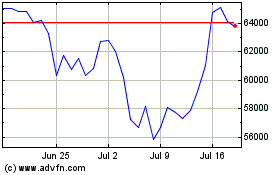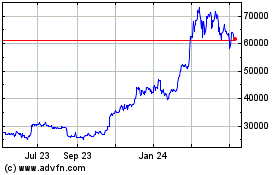Bank Of America Gets Patent For System To Secure Crypto Storage
November 12 2018 - 5:51AM
ADVFN Crypto NewsWire

The second largest bank in America has
won a patent that will secure cryptocurrency storage through a
‘tamper responsive’ remote storage of private keys. The patent adds
to the growing list of patents that have been secured by
traditional financial institutions. It’s a move that shows the
growing interest in cryptocurrencies from these organizations.
The Problem With Existing Storage
Methods
The patent was initially filed two years ago but was finalized
and entered into the record last week. According to the patent documents, the system
will try to address the problem with existing storage methods for
private cryptocurrency keys.
The document states:
“Such devices do not
provide for a real-time response to such breaches, such that
misappropriation of private cryptography keys is prevented.” The
patent adds that most private keys are stored in regular
consumer-grade devices, and they are “susceptible to being
misappropriated by an entity that desires to usurp a user’s
identity.”
Now with the patent, the bank hopes to serve as the bank for
private keys. A digital safe deposit box that has the necessary
insurance and backing of a significant banking corporation. If they
go ahead and commercialize the ‘product now,’ they are likely to
find a massive market for it.
The bank will offer its clients the ability to know in real-time
when their private keys have been tampered with as well as
providing a solution to the problem. It’s an invention that will
serve all types of clients. However, the biggest beneficiaries will
be crypto exchanges and large clientele who are usually the target
of many hack attempts.
The documents describe a system of
redundant keys. The system will automatically respond to tamper
attempts by deleting the private key from the potentially
compromised device.
“In specific embodiments of the system, the storage
device further includes one or more sensors in communication with
the first processor. In such embodiments of the system, the first
processor is further configured to, in response to receiving the
tamper-related signals from the one or more sensors, delete the one
or more private cryptography keys from the first
memory.”
The system will also perform the function in case there is
physical tampering of the device, like when its stolen.
“In other specific related
embodiments of the system, the one or more sensors further comprise
at least one of a shock sensor, an acceleration sensor, and a
temperature sensor, In such embodiments of the system, the first
processor is further configured to, in response to receiving the
tamper-related signals from at least one of the shock sensor, the
acceleration sensor, and the temperature sensor, delete the one or
more private cryptography keys from the first
memory.”
The third instance where it will delete the private key from the
client’s device is when a malicious code or a virus is
detected.
“In other specific
embodiments of the system, the first processor is further
configured to receive the tamper-related signal, from the computing
node. In such embodiments of the system, the tamper-related signal
indicates that a user has exceeded a predetermined number of
attempts of inputting user authentication credentials to the
authentication routine.”
According to the document, users will have the ability to set
the tamper signals and configure how they are processed.
Source: By
Basil
Kimathi in
Cryptocurrency News
Bitcoin (COIN:BTCUSD)
Historical Stock Chart
From Apr 2024 to May 2024

Bitcoin (COIN:BTCUSD)
Historical Stock Chart
From May 2023 to May 2024
